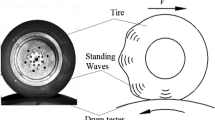Abstract
To investigate static tire enveloping characteristics, a three dimensional (3-D) finite element model is proposed. The vertical stiffness of the tire is studied on a flat surface with and without cleat. Tire rubber materials and cord layers are represented independently using “rebar” elements available in MSC Marc Mentat. Comparisons of numerical and experimental results are given to show the validity of the proposed model. It is shown that after a certain displacement, the results of the proposed model agree well with experimental results. In addition, the model results show that regardless of the type of the cleat placed under the rim center (hub center), all vertical force curves intersect after a certain displacement, which indicates typical static enveloping characteristics. Moreover, another typical characteristic of the radial tires that is unlike those of bias-ply constructions confirms that the contact patch does not expand laterally after a level vertical load is applied to the tire, which is directly related to fuel consumption and tire tread life.
Similar content being viewed by others
Explore related subjects
Discover the latest articles and news from researchers in related subjects, suggested using machine learning.References
Alkan, V., Karamihas, S. M. and Anlas, G. (2009). Experimental analysis of tyre enveloping characteristics at low speed. Vehicle System Dynamics 47,5, 575–587.
Alkan, V. (2008). Prediction of Dynamic Force Characteristics of Radial Tires Using Finite Element and Experimental Techniques. Ph. D. Dissertation. Bogazici University. Istanbul.
Bandel, P. and Monguzzi, C. (1998). Simulation model of the dynamic behavior of a tire running over an obstacle. Tire Science and Technology 16,2, 62–77.
Chengjian, F. and Dihua, G. (2006). The quantitative analysis and experimental verification of the tire static enveloping model using experimental model parameters. Vehicle System Dynamics 44,9, 675–688.
Dihua, G. and Chengjian, F. (2003). Tire modeling for vertical properties including enveloping properties using experimental modal parameters. Vehicle System Dynamics 40,6, 419–433.
Dihua, G., Chengjian, F. and Xie, X. (2005). A dynamic tire model of vertical performance rolling over cleats. Vehicle System Dynamics, Supplement, 43, 209–222.
Hanley, R., Crolla, D. and Hauke, M. (2001). Tire modeling for misuse situations. SAE Paper No. 2001-01-0748.
Kang, N. (2009). Prediction of tire natural frequency with consideration of the enveloping property. Int. J. Automotive Technology 10,1, 65–71.
Lugner, P., Pacejka, P. and Plöchl, M. (2005). Recent advances in tyre models and testing procedures. Vehicle System Dynamics 43,6–7, 413–436.
Lugner, P. and Plöchl, M. (2005). Tyre model performance tests: First experiences and result. Vehicle System Dynamics, Supplement, 43, 48–62.
Mousseau, C. W. and Clark, S. K. (1994). An analytical and experimental study of a tire rolling over a stepped obstacle at low velocity. Tire Science and Technology 22,3, 162–181.
MSC (2005). MSC. Marc Mentat Documentation, A.
Noor, A. K. and Tanner, J. A. (1985). Tire modeling and contact problems, advances and trends in the developments of computational models for tire. Computers & Structures 20,1–3, 517–533.
Tonuk, E. and Unlusoy, Y. S. (2001). Prediction of automobile tire cornering force characteristics by using finite element modeling and analysis. Computers & Structures 79,13, 1219–1232.
Tonuk, E. (1998). Computer Simulation of Dynamic Behavior of Pneumatic Tires. Ph. D. Dissertation. Middle East Technical University. Ankara.
Author information
Authors and Affiliations
Corresponding author
Rights and permissions
About this article
Cite this article
Alkan, V., Karamihas, S.M. & Anlas, G. Finite element modeling of static tire enveloping characteristics. Int.J Automot. Technol. 12, 529–535 (2011). https://doi.org/10.1007/s12239-011-0062-4
Received:
Revised:
Published:
Issue Date:
DOI: https://doi.org/10.1007/s12239-011-0062-4




